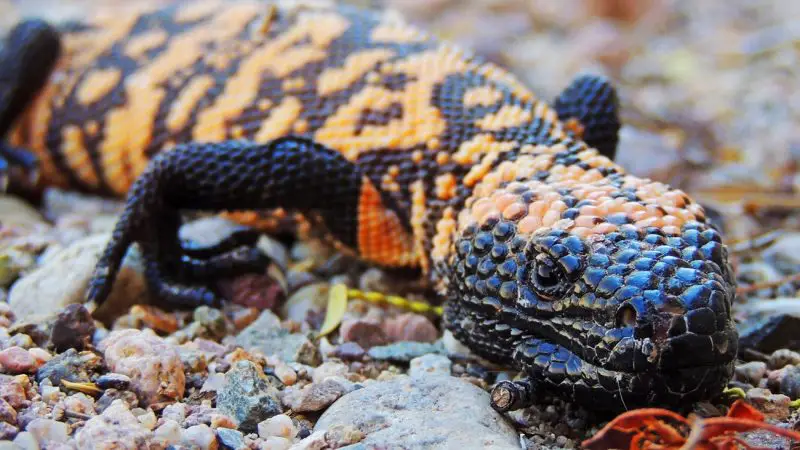Hidden among the rocky canyons and arid deserts of New Mexico lives one of the most mysterious reptiles in North America—the Gila monster (Heloderma suspectum). With its striking black-and-orange bead-like scales and lumbering gait, this lizard has long been surrounded by legend and fear. To the casual observer, it might seem like a dangerous desert predator, but the truth is far more fascinating and complex. The Gila monster is not an aggressor—it is a survivor, a relic of ancient times perfectly adapted to the harsh desert landscapes of the American Southwest.
Few people realize how rare it is to spot a Gila monster in the wild. In New Mexico, these reptiles dwell in secluded habitats, emerging only during certain times of the year. They live secretive lives, spending most of their time underground, and only occasionally venture out to feed or bask in the morning sun. Their elusive nature and venomous reputation have made them one of the least understood species in the region. Yet, beneath their fearsome exterior lies a creature that plays a vital ecological role in maintaining the balance of desert life.
In this detailed article, we’ll explore the secrets about Gila monsters in New Mexico that will truly surprise you—from their hidden behavior and venomous biology to their connection with human medicine and ongoing conservation efforts. By the end, you’ll see why this misunderstood reptile deserves both admiration and protection in the heart of New Mexico’s wild desert.
What Is the Gila Monster?

Physical Description and Adaptations
The Gila monster is one of the most visually unique reptiles in the world. Measuring between 18 and 22 inches in length and weighing up to two pounds, this lizard’s appearance is unmistakable. Its thick, rounded body is covered in bead-like scales called osteoderms, which create a textured armor to protect it from predators and harsh environments. The alternating black and orange or pink coloration is not random—it serves as a warning signal to potential attackers that this reptile carries venom.
Each part of the Gila monster’s body serves a purpose in survival. Its thick tail stores fat reserves that sustain it during months without food or water. Its limbs are short but strong, built for digging burrows and prying open nests. Its forked tongue, like that of a snake, helps it detect chemical cues in the air, allowing it to locate prey hidden underground or within crevices.
A True Venomous Lizard
The Gila monster holds the distinction of being one of only two venomous lizard species in the world—the other being the Mexican beaded lizard. Instead of fangs, Gila monsters have grooves in their lower teeth that channel venom into prey as they chew. The venom is used primarily for defense, not hunting. Their diet consists mainly of bird eggs, nestlings, small mammals, and reptile eggs, so venom helps deter predators rather than subdue prey.
Despite common myths, Gila monsters are not deadly to humans. Their bite is painful and can cause intense swelling, dizziness, and nausea, but fatalities are virtually unknown. They rarely bite unless provoked or handled, and once they clamp down, they may hold on tightly—a defensive behavior rather than aggression.
The Name and Origins
The name “Gila monster” comes from the Gila River Basin, a region that runs through parts of Arizona and New Mexico. Early settlers and explorers first identified the species there in the 19th century. Although the Gila River no longer supports large populations of the lizard due to habitat loss, the name remains a lasting tribute to its discovery in the Southwest.
Habitat and Range in New Mexico
Preferred Environment
In New Mexico, Gila monsters are primarily found in the southwestern region of the state, especially in Hidalgo and Grant Counties. Their habitats stretch across the lower Chihuahuan Desert, where rugged terrain, rocky slopes, and sparse vegetation dominate. The dry climate, punctuated by seasonal rainfall, creates the perfect conditions for these reptiles to thrive.
Their habitats are usually located below 5,700 feet in elevation. Gila monsters prefer desert scrublands, canyons, and foothills, where they can find shelter in burrows, rock piles, or under logs. Because they are ectothermic (cold-blooded), they rely on the sun to regulate body temperature but must avoid overheating. To achieve this, they alternate between basking briefly and retreating into shade or underground tunnels.
Life Underground
A remarkable 90–95% of a Gila monster’s life takes place underground. They occupy burrows dug by themselves or abandoned by other animals, using these cool, humid spaces to escape New Mexico’s extreme desert heat. During the hottest months, they may stay hidden for weeks at a time, emerging only to feed or mate. Their secretive underground life has helped them avoid many predators and survive for millions of years almost unchanged.
Adaptability and Range Expansion
While most people associate Gila monsters strictly with arid desert, they are surprisingly adaptable. In New Mexico, they are also found along the transitional zones of desert grasslands and pine-oak woodlands. These areas offer slightly cooler temperatures and access to different prey types, allowing the species to survive environmental fluctuations. This flexibility has enabled the Gila monster to persist even as climate patterns shift across the Southwest.
Behavior and Daily Life
Solitary and Territorial
Gila monsters are solitary reptiles. Each adult maintains a specific home range, often centered around a network of burrows and rock shelters. Males and females interact primarily during the breeding season, but otherwise, they avoid each other. Encounters between males can lead to wrestling matches, where they grapple and twist to establish dominance—yet rarely cause serious harm.
Feeding and Metabolism
One of the Gila monster’s greatest secrets lies in its metabolism. Unlike many reptiles that must eat frequently, the Gila monster can consume massive meals and survive off them for months. A single nest raid may provide enough food to sustain it for an entire season. Their slow metabolism and fat storage allow them to endure long periods of drought and scarcity, making them one of the most energy-efficient animals in the desert.
Reproduction and Young
Mating typically occurs in the spring after seasonal rains. Females lay between 3 and 12 eggs in burrows, where they remain buried for nearly 10 months—the longest known incubation period among lizards. When the young hatch, they are fully independent and already venomous, equipped to survive from the moment they emerge.
The Venom: Deadly Appearance, Lifesaving Secret
How Gila Monster Venom Works
Gila monster venom is a complex mix of proteins and enzymes designed to deter predators and immobilize prey. Delivered through grooves in their teeth as they chew, it causes immediate burning pain and inflammation. Although not lethal, the bite should always be treated medically due to its intensity and potential allergic reactions.
Medical Discoveries
Perhaps the most surprising secret of all is how the Gila monster’s venom has benefited humans. Scientists discovered a peptide in its saliva called exendin-4, which mimics a human hormone involved in insulin regulation. This breakthrough led to the development of exenatide (Byetta), a revolutionary drug used to treat type 2 diabetes. Today, this medicine has improved the lives of millions, showing that nature’s deadliest defenses can also be humanity’s greatest allies.
Myths and Misconceptions
For decades, settlers believed wild tales about Gila monsters—claims that their breath could kill or that their bite was instantly fatal. These myths contributed to widespread fear and unnecessary killing. In reality, Gila monsters are shy and non-aggressive creatures. They prefer retreating to their burrows over confrontation and only bite when cornered or mishandled.
Conservation and Protection
Status in New Mexico
The Gila monster is officially listed as a “Species of Greatest Conservation Need” in New Mexico. Although not endangered nationwide, it is considered rare within the state due to habitat fragmentation and illegal collection. Their slow reproductive rate makes it difficult for populations to rebound once disrupted.
Major Threats
Human expansion remains the biggest threat to Gila monsters. Urbanization, mining, and road development continue to encroach on their desert homes. Many individuals are killed by vehicles when crossing roads, especially during their brief active periods. Additionally, the illegal pet trade poses a persistent problem, as collectors seek these reptiles for their exotic appearance.
Conservation Efforts
Wildlife agencies and researchers in New Mexico are working to better understand and protect the Gila monster. Conservation strategies include habitat preservation, public education, and tracking programs using radio telemetry to study their movement patterns. By preserving natural desert ecosystems, these efforts aim to secure a future for this ancient species.
Fascinating Secrets You Didn’t Know
They Store Both Fat and Water
The Gila monster’s tail is not just a fat reserve—it also stores water. This adaptation allows the lizard to survive months of extreme drought without eating or drinking. When conditions improve, it replenishes these reserves during brief feeding binges.
They Are Rain-Loving Reptiles
Despite being desert dwellers, Gila monsters are most active after rainfall. Moisture brings cooler air and an abundance of prey, making it an ideal time to forage. In New Mexico, after a rare desert storm, you’re most likely to see one crossing a road or basking near rocks.
Their Colors Are a Warning
While most reptiles rely on camouflage, the Gila monster uses bright coloration to advertise danger—a defense mechanism called aposematism. The bold orange and black patterns serve as nature’s “Do Not Touch” sign, warning predators that it is venomous and not worth the risk.
Their Bite Is Painful but Not Fatal
When threatened, the Gila monster delivers a painful but non-lethal bite. Its powerful jaws can latch on for several minutes, chewing venom into the wound. Though the pain is intense, medical treatment ensures full recovery in most cases.
They Can Live for Decades
Gila monsters are surprisingly long-lived. In the wild, they can live more than 30 years, and in captivity, some have survived over 40. Their slow pace of life and energy-efficient metabolism make longevity one of their most astonishing traits.
Spotting and Staying Safe in New Mexico
Best Time to See Gila Monsters
If you hope to see a Gila monster in the wild, timing is everything. They are most active in spring and early summer, especially after rainstorms. Early mornings or late afternoons, when temperatures are mild, are ideal times to spot them basking on rocks or moving across trails.
Safety Guidelines
- Never approach or attempt to handle a Gila monster.
- Keep pets and children at a distance.
- Observe from a safe distance using binoculars or a zoom lens.
- Report illegal captures or injured animals to local wildlife authorities.
Ethical Observation
The best way to enjoy Gila monsters is through respectful observation. Wildlife photographers and nature enthusiasts should avoid disturbing burrows or using artificial lighting. Responsible wildlife viewing helps ensure these reptiles remain undisturbed in their natural habitat.
FAQs About Gila Monsters in New Mexico
Is the Gila monster dangerous to humans?
Not usually. The bite is painful but rarely life-threatening. Prompt medical attention helps manage symptoms and prevent complications.
Can I keep a Gila monster as a pet in New Mexico?
No. It is illegal to possess or sell a Gila monster in New Mexico without a permit. They are protected by state and federal law.
What do Gila monsters eat?
They feed on eggs, small mammals, birds, and carrion. Their keen sense of smell allows them to detect prey underground or hidden in nests.
How long do they live?
In the wild, they can live 25–30 years. Captive specimens have been known to reach 40 years or more.
Why are they so rarely seen?
Their secretive, underground lifestyle means they spend most of the year hidden. They emerge mainly in spring, after rainfall, or during breeding season.
What are their biggest threats in New Mexico?
Habitat destruction, illegal pet collection, and road mortality are the main threats. Conservation efforts aim to reduce these impacts through public education and habitat protection.
How can people help conserve them?
Support conservation programs, avoid disturbing their habitat, and report illegal wildlife trade. Educating others about the ecological importance of Gila monsters is one of the most effective ways to protect them.
Conclusion
The Gila monster is one of New Mexico’s most mysterious and remarkable creatures—a living relic of the desert that continues to amaze scientists and nature lovers alike. Its venom, once feared, now helps save lives; its slow pace hides extraordinary endurance; and its colorful skin serves as a symbol of survival in one of the planet’s harshest climates.
By learning the truth about Gila monsters and protecting their fragile habitats, we honor not just one species, but the entire ecosystem that depends on it. The next time you wander through New Mexico’s sun-baked canyons or rocky plains, remember—beneath your feet may lie one of the desert’s most astonishing secrets, quietly living its ancient life, waiting for the rain.






